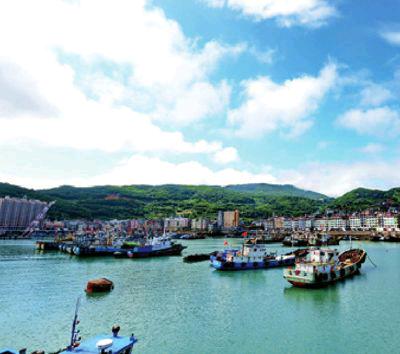Spearheading Maritime Initiatives
2014-12-19ByhouWeili
By+hou+Weili
To become a 21st Century Maritime Silk Road hub, Fuzhou, capital of southeast Chinas Fujian Province, is focusing on trade cooperation, traffic connectivity and people-to-people exchanges, starting with the Association of Southeast Asian Nations (ASEAN). Gradually the cooperation and exchanges are expected to extend to Europe, North America, Africa and Oceania.
Statistics by the Fuzhou Municipal Development and Reform Commission show the citys trade with ASEAN, the Middle East and Africa exceeded $6.4 billion by the end of 2013, accounting for 20 percent of Fuzhous total foreign trade. In this period, ASEAN countries invested $895 million in the city.
Waterway connectivity
Traffic connectivity is essential for promoting the cooperation. With its coastline taking up one third of coastal Fujian Province, Fuzhou has a wealth of ports to develop waterway transportation.
“The initiative to establish Fuzhou as a maritime hub along the 21st Century Maritime Silk Road gives me a clearer direction for the future development of my business,” Zheng Ming, General Manager of Fuzhou International Container Terminal, the largest container shipping contractor in Fuzhous Jiangyin Port, told Beijing Review.“We will put more ships on Southeast Asian and African routes.”
Growing business on these routes has bolstered Zhengs confidence. As of October, shipments on Southeast Asian routes had increased 60 percent year on year, the most prominent increment in the companys business. “Im confident routes to countries along the [21st Century] Maritime Silk Road will be lucrative,” Zheng added.
On October 31, the Jiangyin Port was connected with Chinas railway network by a branch of the high-speed Fuzhou-Xiamen Railway, marking the beginning of sea-railway combined transportation. With two daily freight trains, the Jiangyin Port can transport 60,000 to 70,000 20-foot equivalent units(TEUs) of containers annually. “This [conve- nient transportation] will improve access to the ports hinterland, opening up its industries to the vast international market,” said yang yimin, Mayor of Fuzhou.
yang is proud of the citys long historical connection with Chinas ancient Maritime Silk Road. On several occasions, he has drawn attention to the citys historical trades with foreign countries along the route by exhibit-ing a porcelain pot made during the reign of the Tang Dynasty(618-907). The exquisite relic was excavated from an ancient kiln in Huaian, a conserved historic site in Fuzhou. Similar porcelain objects have been found in Japan and Southeast Asian countries along the ancient Maritime Silk Road.endprint
“[Fuzhous ancient] foreign trade has left the city with valuable legacies and laid a foundation to respond to President Xi Jinpings initiative to establish the 21st Century Maritime Silk Road,” yang said.
According to the action plan, the Jiangyin Port will have 15 terminals by the end of 2015. As a world-class container port, it will then be able to handle 5 million TEUs every year.
Fuzhous ports are playing a greater role in boosting the economy and attracting investment. Chemical manufacturing is becoming the pillar industry in the Jiangyin Port. Five chemical factories are under construction by companies such as China Petrochemical Corp. and Fujian Southeast Electrochemical. They signify an investment of 5.5 billion yuan ($895 million). When all the production lines are put into operation, the annual output will be worth 100 billion yuan ($16 billion).
Fishery cooperation
Fuzhou is reinforcing efforts to boost fishery cooperation with the countries along the Maritime Silk Road. Last year, its fishing industrys output was worth 90.46 billion yuan ($14.65 billion)—45 percent of Fujians total, according to Chen Zhenguang, Deputy Director of Fuzhou Oceanic and Fishery Administration.
The focus is on cooperation in pelagic fishery, aquaculture and aquatic products processing. Fuzhou is a forerunner in pelagic fishery. Its fishing vessels have footprints in over 20 national exclusive economic zones across the world. According to Chen, Fuzhous pelagic fishery segment boasted 15 companies and 395 vessels in 2013, contributing 227,900 tons, the largest yield in China. Fuzhou also built seven overseas pelagic fishery bases in Indonesia, Myanmar, Mauritania and Guinea-Bissau. “These are complexes with units for fishing, aquaculture, processing, cold chain logistics and vessel maintenance,” Chen said.
Fuzhou businesses have built aquafarms in Indonesia and Thailand. “Although the farms are relatively small, they are promising. Our breeding techniques can be shared with locals in this way,” he said.
On November 2, the China-ASEAN Seafood Exchange Center opened in Fuzhou, a key project to accelerate the citys development as a maritime hub. Jiang Xiong, President of the center, said it expects to see an annual trade volume of 2 million tons. “The win-win cooperation will reinforce China and ASEANs position as an integrated power in the fishery industry internationally,”Jiang said.
Mayor yang highlighted the importance of improving fishery products added value and transferring technology in the cooperation process. “We encourage Fuzhou businesses to invest in shipbuilding plants in countries along the road and share building technology,” yang said.
The private sector is joining forces. The China International Fair for Investment and Trade in Xiamen this September saw the establishment of the China-Africa Maritime Silk Road Investment Co. and the Maritime Silk Road Investment Fund Management Center on Langqi Island in Fuzhou.
Huang Jianhui, Manager of the center, said the company has a registered capital of 500 million yuan ($81.5 million). It plans to raise over 100 billion yuan as a capital pool to support projects in African countries along the Maritime Silk Road.
“It aims to establish an economic belt to revitalize the ancient trading corridor and become a modern passageway for trade and cultural exchanges between China and African countries,” Huang said.endprint
